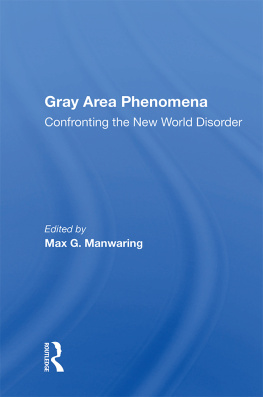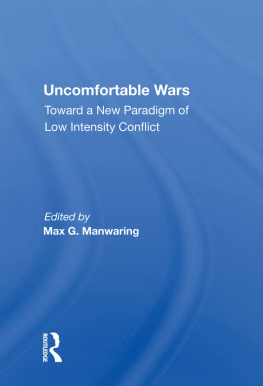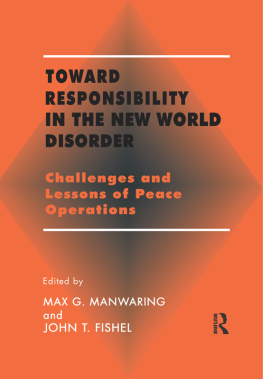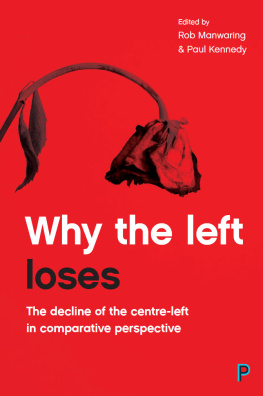Gray Area Phenomena
Westview Studies in Regional Security
Wm. J. Olson, Series Editor
Gray Area Phenomena: Confronting the New World Disorder, edited by Max G. Manwaring
Suppressing Insurgency: An Analysis of the Malayan Emergency, 1948-1954 edited by John Coates
Low-Intensity Conflict: Old Threats in a New World, edited by Edwin G. Corr and Stephen Sloan
The Military, the State, and Development in Asia and the Pacific, edited by Viberto Selochan
The Comandante Speaks: Memoirs of an El Salvadoran Guerrilla Leader, edited by Courtney E. Prisk
Uncomfortable Wars: Toward a New Paradigm of Low-Intensity Conflict, edited by Max G. Manwaring
U.S. Strategic Interests in the Gulf Region, edited by Wm. J. Olson
FORTHCOMING
The U.S. Counterinsurgency Campaign in Thailand, edited by William Rosenau
Gray Area Phenomena
Confronting the New World Disorder
Edited by
Max G. Manwaring
First published 1993 by Westview Press
Published 2018 by Routledge
52 Vanderbilt Avenue, New York, NY 10017
2 Park Square, Milton Park, Abingdon, Oxon OX14 4RN
Routledge is an imprint of the Taylor & Francis Group, an informa business
Copyright 1993 Taylor & Francis
All rights reserved. No part of this book may be reprinted or reproduced or utilised in any form or by any electronic, mechanical, or other means, now known or hereafter invented, including photocopying and recording, or in any information storage or retrieval system, without permission in writing from the publishers.
Notice:
Product or corporate names may be trademarks or registered trademarks, and are used only for identification and explanation without intent to infringe.
A CIP catalog record for this book is available from the Library of Congress.
ISBN 13: 978-0-367-01180-2 (hbk)
Contents
, Wm. J. Olson
, Max G. Manwaring
, Ambassador Edwin G. Corr
, Wm. J. Olson
, Scott B. MacDonald
, Max G. Manwaring
, Courtney E. Prisk
, Bruce Zagaris
, John T. Fishel
, Max G. Manwaring, Robert M. Herrick, and David G. Bradford
, Ambassador David C. Miller, Jr.
, Ambassador Edwin G. Corr
Guide
Snug in seraphic Cupboards
To nibble all the day,
While unsuspecting Cycles
Wheel solemnly away!
Emily Dickinson
Great forces operating over many years, little understood and often unsuspected, worked to create individual nation-states and through their interconnections the international system. The process encompassed generations of labor, considerable violence and confusion, and an unstable pattern of states and complex relationships. One of the dominant features of this pattern that emerged in the years following World War II was the superpower rivalry between two very different nation-states organized around fundamentally different concepts. Their struggle helped to frame much of the nature of international politics for over 40 years. Frame, yes, but it also helped to obscure a deeper process of change and transfiguration, the lineaments of which are beginning to emerge only now.
The rise and fall of nations, fragmentation and rebirth, struggle and collapse are the themes that once again seem to predominate the images of our present as they once troubled earlier generations. A new reality, long under the concealing shadow of East-West confrontation, emerges. It is a time of great uncertainty in which old patterns seem to have been rubbed smooth and new patterns have yet to take definitive shape. It is in this environment of change and discontinuity that we must now find our way. But what sight arid theodolite do we use to survey this new landscape?
Part of our present confusion is that there are as many voices raised in answer as there are people. Uncertainty as to the depth and true nature of the problems or the forces that generate them has not discouraged every variety of answer. Yet, we are no closer to an accurate abstract. Nevertheless, we still find urgent calls upon our resources and resolve to come to the aid of friends and former enemies. We find a growing list of truly needy cases that demand our attention and threaten our security.
In the years just past, we had a clearer idea of how to respond. The demands of collective security in an age defined by the certitude of U.S.-Soviet rivalry were sufficiently concrete to permit a reasonable surety in policy and action. The intellectual and political coherence of policies that saw security and peace as indivisible may have made the United States the world's policeman, but they also permitted a sound foundation upon which to plan, to structure requirements, to build strategies and force structures, to sell the need for the sacrifices of action to the public. Those verities have passed with the Cold War. The content may have passed but there are considerable form and structure, institutional habits and ways of thought that remain. In this new environment, it appears that the response that is emerging is to regard chaos as indivisible. The implications of this are that we must trade being the world's policeman for becoming the world's social worker. This may, indeed, be the case, but as yet no one has sufficiently defined the terms of reference or outlined the projected costs of such a philosophy for the future; or has begun to engage the publicwithout whose commitment all else is fancyon whether they are willing to sustain this even greater call upon their tolerance and pockets than the more limited and clear demands of Cold War rivalry. Habit and drift seem more the determinants shaping policy than any sober understanding of the demands that such a future presents. Yet, the problems persist and grow worse, unwilling to wait patiently for us to carefully decipher their meaning.
Thus, it seems that we are suspended between the choice of engagement in circumstances uncertain and dangerous or a retreat to semi-isolation; commitment or disengagement. This volume will not resolve these mysteries. It does, however, raise some of the basic questions and outlines some of the essential approaches to answering them. It is part of that critical dialogue with ourselves that must go forward if we are to choose wisely and well how best to meet the future. The authors hope that it will help to promote the sustained discussion of issues and actions that will help us not only define the new landscape but to pioneer its peaceful settlement.
Wm. J. Olson
Washington, D.C.
This book is part of a continuing effort initiated by General John R. Galvin to revitalize strategic thinking as it pertains to "uncomfortable" contemporary wars. It evolved from his call for a new paradigm to fight the most prevalent and most likely forms of conflict in the world today. These conflicts range from acts of terrorism, insurgencies, and illegal drug trafficking to warlordism, militant fundamentalism, ethnic cleansing, and civil war to other transnational threats and consequences of instability. This is the so-called "gray area phenomenon" (GAP). It is not new. What is new is that the ending of the Cold War has allowed GAP issues to emerge as major problems in their own right.
War is no longer fought only by the military; it now encompasses entire populations and its outcome depends more and more on the forgotten societal dimensions of conflict. Using the "White Triangle" of the cocaine trade in the Americas and other contemporary examples, this book analyzes the gray area phenomenon, offers concrete proposals for countering the strategic problems inherent in it, and provides the basic architecture for a theory of engagement. By coming to grips with the most salient analytical commonalities that dominate contemporary conflict, decision makers and their staffs should be able to develop the vision necessary to initiate a holistic strategy to win a contemporary warnot just the battles but the war itself.














